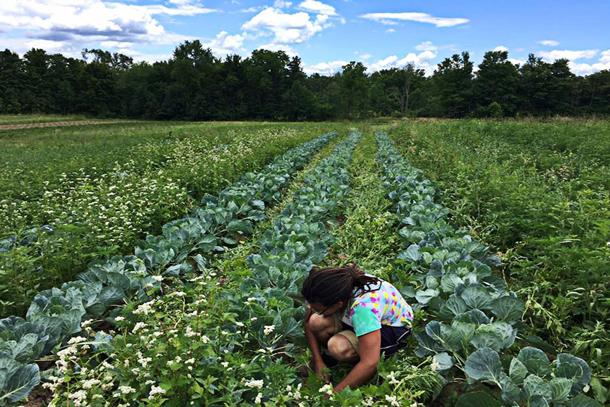Wild swings in the weather mean that some farm crops will flourish, while others struggle
On Matt Herbruck’s Pennsylvania farm, they’ve shifted away from growing leafy greens because of changes in the weather.
Wide-spread droughts and heat waves are making farming increasingly unpredictable, and some farmers are having to adjust on the fly to changing conditions from year to year.
After 22 years, Pennsylvania farmer Matt Herbruck says it’s undeniable: The climate is changing and it’s getting more extreme. “It’s not unusual at all in this area to go from in the 40s one night to 90 [degrees] 36 hours later. It happens. And that’s not normal. I think the weather is crazy.”
In 2016, Pennsylvania and Herbruck had to contend with unusually hot and dry conditions — temperatures 5 to 10 degrees above average and 10 fewer inches of rainfall — which meant planting different crops than in previous years. With insufficient water to grow lettuce and leafy greens, Herbruck says he “went big into peppers and eggplants and things like that. Unfortunately, peppers are really not the most lucrative crop, but we had a lot of them, so that was nice.”
Franklin Egan, director of education at the Pennsylvania Association for Sustainable Agriculture, says he hears about the changing weather a lot from local farmers — and he says it’s more than just talk. Egan points to data from the USDA which show that while the amount of annual rainfall in Pennsylvania and the Northeast US has increased only slightly in the past 50 years, the way it’s coming down has changed.
“We’ve been getting a lot more extreme rainfall events,” he says. “The amount of extreme rainfall we’ve gotten has increased fully 71 percent.” To Egan, this is a startling number. It’s also a far bigger change than in any other part of the country.
“If you put that together — about the same annual rainfall, but more intense rainfall — that means that Pennsylvania farmers are dealing with this paradox of way too much water at certain points of the year, punctuated by short, but often fairly intense drought periods,” Egan says.
According to Pennsylvania’s Climate Assessment, last updated in 2015, extreme rain events will get worse, and summer heat waves will get more frequent and intense. This means places like Harrisburg will feel more like Birmingham, Alabama. Whether that’s good or bad largely depends on what a farm produces. Pennsylvania farms produce a wide variety of products, from dairy, poultry and eggs to corn, vegetables, nuts and fruits.
Pennsylvania’s agriculture secretary, Russell Redding, says “there are going to be winners … in terms of their ability to grow extended seasons and different crops, and there will be a downside, because there’s a lot of production agriculture that will not be able to tolerate the continued swings of rainfall and temperatures.”
On the upside, for example, new varieties of fruit are already being grown in the state. Apple varieties common to the Shenandoah Valley, in Virginia, are now in Pennsylvania.
On the downside, the warming conditions are implicated in new, unwanted pests. The Agriculture Department recently issued quarantines in six counties to prevent the spread of the spotted lanternfly, a black, red and white insect that first appeared in Pennsylvania and other places in the US just a few years ago. The fly could devastate the state’s tree fruit and grapevines.
For many farmers, these unanticipated changes and all the variability mean they have to continually adjust their plans to suit the warming weather. Dairies are adding air conditioning to keep cows cool enough to produce milk. In fields, more farmers are adding irrigation systems to use during dry periods. And more crops are being grown in hoop houses, for better protection from weather and pests.
Matt Herbruck says for years now he has been shifting away from working the fields in July. “Stuff doesn’t grow that well,” he says, “and also, I’m not going out there when it’s 95 degrees. Who wants to do that?”
But he also sees some of the benefits of climate change. Nowadays, October is usually still warm enough for planting, so he’s still selling produce in November and December.
This article is based on a report by Julie Grant for the Pennsylvania public radio program, the Allegheny Front. The report aired on PRI's Living on Earth with Steve Curwood.
